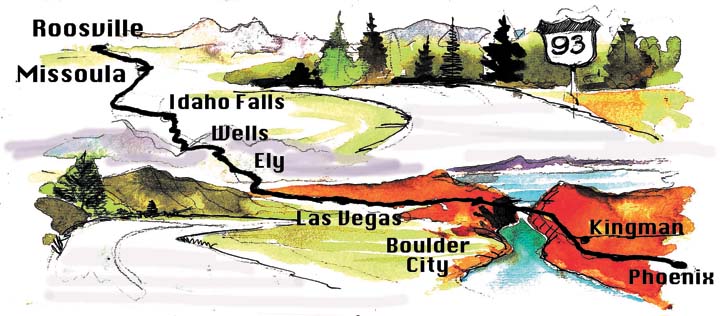New guidebook valuable asset for exploring U.S. 93
A new guidebook on U.S. Highway 93 in Arizona and Nevada debuts this summer, joining an informative line-up of special publications from the Bureau of Mines and Geology at the University of Nevada, Reno. "A Geologic and Natural History Tour Along U.S. 93" delivers a fascinating journey of 700 miles from Wickenburg, Ariz., to Jackpot on the Nevada-Idaho border.
The book compiles field trip notes and input from many contributors over several years. Authors include Joseph V. Tingley and Kris A. Pizarro of the Nevada Bureau of Mines and Geology, Christopher Ross of the Bureau of Land Management and Philip A. Pearthree of the Arizona Geological Survey.
Designed to be used while traveling, the softcover book's spiral-bound 8½-by 11-inch pages open flat for easy reading. The 175-page U.S. 93 guide includes 12 full-color photo pages, 260 black and white photos, maps, diagrams and artists' illustrations.
The text is keyed to highway mile markers for use with your vehicle's odometer. For the convenience of readers so equipped, an appendix provides GPS coordinates for key points of interest. A glossary supplies the meaning of technical terms, especially pertaining to geology. If you absorb all the geological jargon, observations and examples provided in this guide, you'll be well on your way through a college geology course.
The trip described using U.S. 93 should be done in segments or during several days of travel. Southern Nevadans already familiar with U.S. 93 from Hoover Dam through the Las Vegas urban area might want to start using the guide after they head north from the city. For Southern Nevadans, the 200 miles of northwestern Arizona described in the guide would make sense as a short trip south from the dam to old Wickenburg.
Of course, the distance covered by the guidebook can be accomplished in a long day's drive, but a forced march allows no time for side trips or interesting stops along the way. The book suggests many opportunities to explore parks, ghost towns, museums and scenic or historic routes connected with U.S. 93. Historical sidelights enrich the text, providing insight into the happenings of yesteryear when Arizona and Nevada first developed as territories and later became states.
Using this guide, how can you resist digressing to historic towns such as Chloride in Arizona or Pioche or Panaca in Nevada? Why not allow time for Arizona's Grand Canyon West or Nevada's Great Basin National Park or more than a half a dozen scenic state parks not far off U.S. 93?
The new guidebook describes many of the key plants and animals found along the route by those who slow down to observe them. Since the route traverses three of the continent's four deserts as well as skirting high mountains, the wildlife and plant communities vary greatly. Sightings of deer, coyotes, pronghorn antelope and even elk are not uncommon. Scanning the skies, most travelers spot hawks, eagles and vultures as they float above the landscape. Those who pause where there is water such as at the Pahranagat Lakes or in parks like Beaver Dam, Spring Valley, Echo Canyon or Cave Lake, will observe many more of the variety of creatures that inhabit areas reached by U.S. 93.
Shipped last month, the first printing of the new U.S. 93 Guidebook, Special Publication 35, numbers 3,000 books. Selling for $27.95, the book is a valuable addition to personal reference publications for anyone who appreciates the West, specifically Nevada and Arizona. Until Aug. 31, the new book may be paired with the guidebook to the Las Vegas area, Special Publication 16, for a special "twofer" price of $50.
Order the publications from the Nevada bureau of Mines and Geology by phone at (775) 682-8766 or online at www.nbmg.unr.edu. The NBMG office is now located in the Great Basin Science Sample and Records Library, 2175 Raggio Parkway, Reno, NV 89512.
Margo Bartlett Pesek's column appears on Sundays.






















